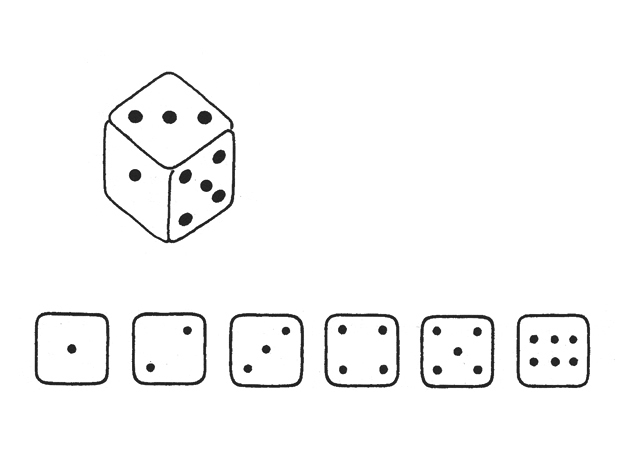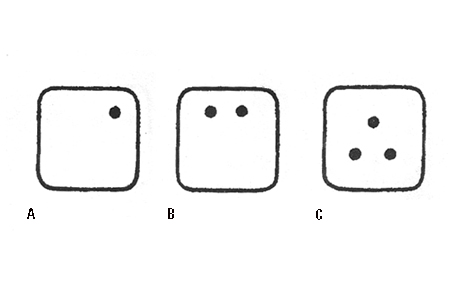Remembering a figure
We will preface all considerations of sign production by a very simple test of pure memory. As the object of the exercise We choose dice, with the six images that must have created a pictorial impression in the mind of every reader. The intensity of the impression of the figure shown and the strength of feeling that it releases will vary from one person to another, depending on their experience in encountering the signs: superficially as children or deeply as gamblers.
There are six figures that are familiar to the dice player, who need neither “decode” nor count them. Recognition is spontaneous because they conform to a known pattern, a learned and experienced scheme of thought. A simple displacement of the dots to unaccustomed positions causes involuntary frustration to the viewer.
われわれにとってサイコロはとても馴染み深いもので、特にサイコロの丸い点を数えることなく利用しています。
認識とは知識や経験から自然に起こるものです。
サイコロの点がいつもと見慣れない位置にくることで無意識に違和感を感じるでしょう。
The displaced dot of the figure one (A) immediately creates uneasiness. The feeling of the idea of “center” (security, stasis) is anchored in the feeling of symmetry.
All symmetrical arrangements are closer to the structure of our body and therefore more accessible, easier to understand, in contrast with asymmetry, which needs rather to be grasped by the mind. The displaced dot also raises the doubt as to whether it is not perhaps one half of the familiar figure two.
An alienating figure two (B) is far removed from the customary diagonal arrangement, which divides the face of the dice into two equal parts. Here the dots are not “fixed” but suspended. The association with eyes in a face is not to be ruled out.
This information is originated from the Signs and Symbols by Adrian Frutiger in part.
It’s strongly recommended that if you will read a Signs and Symbols by Adrian Frutiger thoroughly, you are able to understand with this information on a more than superficial level.
それではまず最初に図Aの出目「1」を見てみましょう。「1」を示す真ん中にきているはずの点がいつもと違うところにくることでわれわれは困惑してしまいます。
真ん中に点を配置するということは、対称的な感覚を植え付けます。
非対称なものは、存在している位置(右上なのか、左下なのかなど)を頭で考えないと受け入れることができないことに対して、
対照的な配置はわれわれの体の構造と密接な関係があるために、
より受け入れやすく、用意に理解することができるです。
続いてまず見ることのない図Bの出目「2」の配置は、2つの点が馴染みのある対角線上から全く違う場所に配置してあります。この配置により、面は2つに分割されてしまいしっくりこない状態になります。
次にお見せする図Cの出目「3」は前述と違い、われわれと馴染みのある3つの点の配置と明らかに違いますが、視覚的なバランスを大きく乱すものではありません。
しかし、これは典型的なサインである三角形を示してしまうことになり、かえってわれわれにとって「3」という出目よりも三角形というオブジェクトの存在を感じさせてしまいます。
このコンテンツはSigns and Symbols by Adrian Frutigerから一部引用したものです。
次のことをお勧めします、もしあなたがSigns and Symbols by Adrian Frutigerを熟読すると、このコンテンツを表面的なレベルより深く理解することができます。

